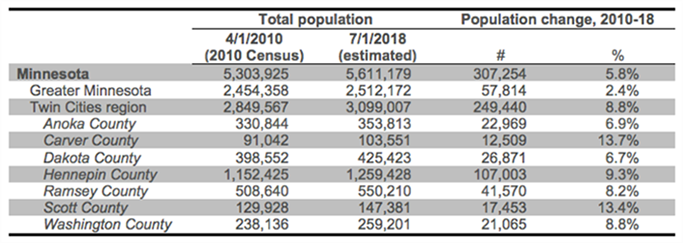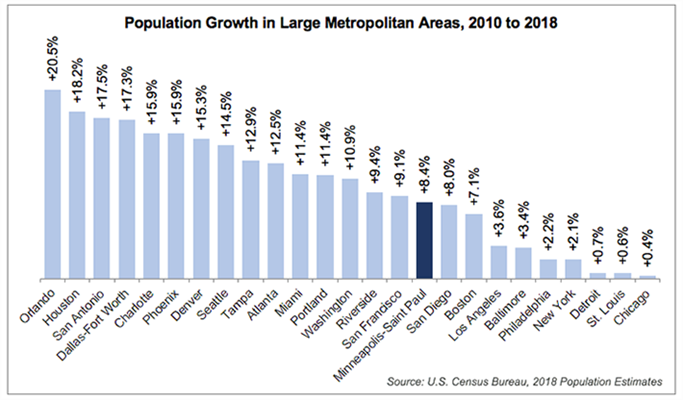Steady population growth confirms Met Council forecast
The U.S. Census Bureau on Thursday, April 18, released population estimates for each county and metropolitan statistical area (MSA) in the country as of July 1, 2018. The data show the estimated population of the 7-county Twin Cities region totaled approximately 3,099,000.
The Metropolitan Council forecast for 2020 anticipates continued steady population growth of +1.0% per year. And. in fact, the Census data confirm that forecast. Population in the metro area increased by about 249,000 since April 1, 2010, an increase of 8.8%.
The region is currently home to about 55% of the state’s population and accounted for 81% of the state’s net population growth since 2010.
Among the counties in the Twin Cities region, Hennepin County had the largest numerical population increase (+107,000), while Carver and Scott Counties had the highest cumulative growth rates (+13.7% and +13.4%).

About two-thirds of the region’s estimated population growth came from “natural increase” (more births than deaths). The remainder of the increase came primarily from international migration (more people moving into the region from outside the U.S. than moving out).
Growth slower than peer regions
Considering our region in a national context, the broader 16-county MSA* has experienced the 16th-fastest growth rate (+8.4%) among the country’s 25 most populous metro areas. This is faster than the nation as a whole (+6.0%) as well as some older, more established metro areas, such as Boston, New York and Chicago, but still slower than peer regions like Denver, Seattle and Portland.

Growth 3rd highest among major Midwest metro areas
Among major metropolitan areas in the Midwest (those with an estimated population of at least 1 million), the Minneapolis-Saint Paul metropolitan statistical area’s growth rate (+8.4%) is the third-highest, below only Columbus (+10.8%) and Indianapolis (+8.5%).

The Census Bureau’s county population estimates serve as a consistency check for the Metropolitan Council’s own population estimates for cities and townships in the seven-county area. These estimates (for April 1, 2018) will be prepared and delivered to cities in May 2019, then certified and released publicly by July 15.
*Note: The broader 16-county Minneapolis-Saint Paul-Bloomington metropolitan statistical area includes Chisago, Isanti, Le Sueur, Mille Lacs, Sherburne, Sibley, and Wright Counties in Minnesota and Pierce and St. Croix Counties in Wisconsin. According to the Census Bureau’s 2018 population estimates, the Twin Cities region constitutes 85% of the 16-county metropolitan area’s population and 89% of the metropolitan area’s net population growth since 2010.